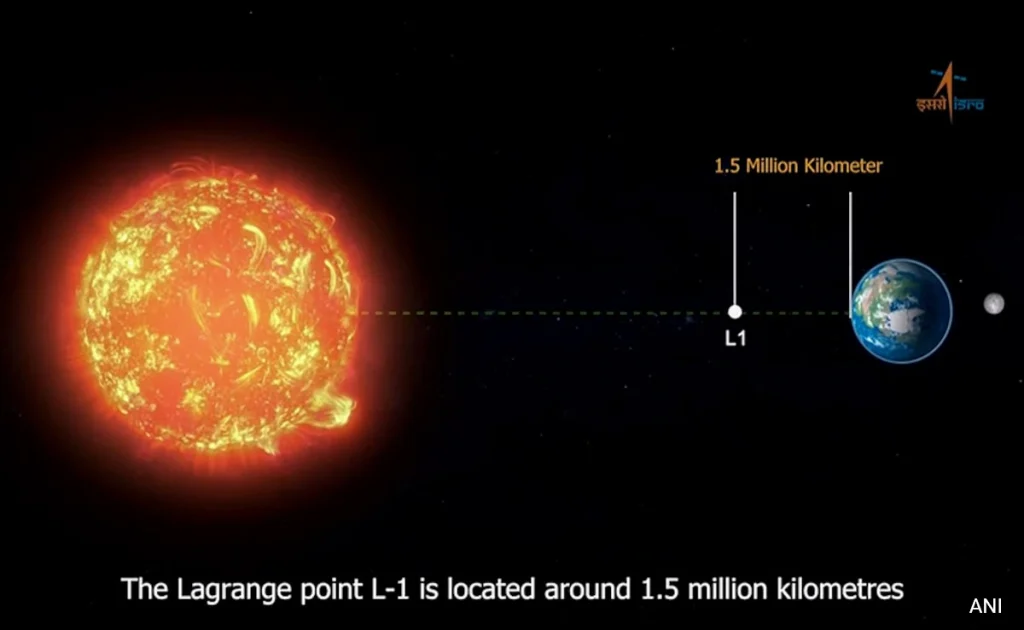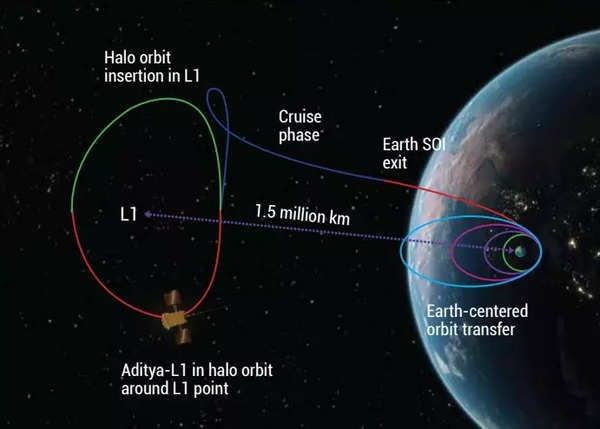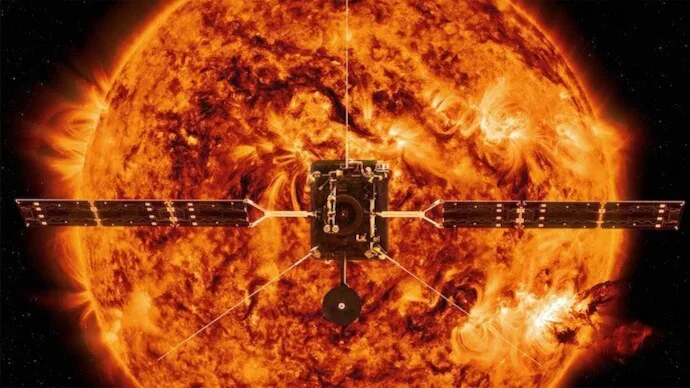Aditya-L1 has smoothly glided into a special ‘halo’ orbit around the Earth-Sun L1 point. From here, it’ll be keeping a close eye on the Sun for the next five years. Get ready for some enlightening insights into our star!
A mere four months after the historic Moon landing, the Indian Space Research Organisation (ISRO) has achieved another milestone. On a Saturday afternoon, ISRO successfully placed its Aditya-L1 spacecraft into its designated orbit. This marks India’s inaugural mission dedicated to unraveling the secrets of the Sun, showcasing ISRO’s prowess in executing intricate and cutting-edge space endeavors.
Aditya-L1 has smoothly entered the ‘halo’ orbit around the L1 point in the Earth-Sun system. Positioned at the Lagrange 1 point, or L1, this spacecraft will spend the next five years observing the Sun. L1 is a gravitational sweet spot where Earth and Sun forces balance, providing a stable parking spot for satellites. Situated approximately 1.5 million kilometers from Earth, it’s just 1% of the total distance between our planet and the Sun.
ISRO Chairman S. Somanath highlighted Saturday’s focus on precisely situating Aditya-L1 in the designated ‘halo’ orbit. While the spacecraft was on track for the orbit, some adjustments were needed. Somanath explained that minor corrections, totaling around 31 meters per second in velocity, were crucial to ensure the satellite maintained the correct orientation. It’s a delicate dance in space, where precision is key to the success of the mission.

“In this fresh orbit, precise placement was crucial. Without the corrections made today, there was a risk of it drifting away from the designated L1 point. We couldn’t afford any escape. While there were potential contingencies, I want to stress that, mathematically speaking, there was a possibility of it drifting away. Our actions were executed with utmost precision to prevent any such scenario,” he added.
The achievement of ISRO scientists lies in the meticulous placement relying on “precise measurements and accurate predictions of the required velocity.” The Aditya-L1 spacecraft now follows a periodic orbit, tracing the ever-shifting Sun-Earth line. Its orbital cycle spans approximately 177.86 Earth days, showcasing the agency’s adeptness in calculating and orchestrating precise celestial maneuvers.
“The choice of this particular ‘halo’ orbit is strategic, ensuring a mission longevity of 5 years with minimal station-keeping maneuvers, thereby reducing fuel consumption and guaranteeing an uninterrupted view of the Sun. The triumph in this orbital insertion not only underscores ISRO’s prowess in intricate orbital maneuvers but also instills confidence in tackling upcoming interplanetary missions,” stated ISRO, celebrating both the present accomplishment and the promising future it heralds.
Placing the Aditya spacecraft in the ‘halo’ orbit around the L1 point proved to be a unique challenge, unlike the routine task of orbiting Earth, Moon, or Mars. As A N Ramaprakash, a senior professor at the Inter-University Centre for Astronomy and Astrophysics (IUCAA) in Pune, pointed out, L1 is not a physical object but rather an empty space – a location. The orbit around L1 is exceptionally intricate, nearly perpendicular to the Earth-Sun axis. This required a highly demanding maneuver for insertion, and even after successfully achieving it, ISRO must conduct periodic correction maneuvers to maintain the spacecraft’s position in this challenging orbit.
The success of Saturday’s intricate manoeuvre was officially announced by Science and Technology Minister Jitendra Prasad, eliciting a congratulatory message from Prime Minister Narendra Modi, known for his avid interest in India’s space endeavors.
“India achieves another historic milestone. Aditya-L1, our inaugural solar observatory, reaches its designated orbit. A testament to our scientists’ unwavering commitment to accomplishing some of the most complex space missions,” Modi shared on his official handle.
“Joining the nation in applauding this remarkable achievement, we remain dedicated to exploring new frontiers of science for the betterment of humanity,” Modi affirmed, celebrating the nation’s progress in space exploration.
ISRO has done something really cool – they’ve put a spacecraft called Aditya-L1 at a special spot near the Sun called the L1 point. This makes ISRO only the third space agency, after NASA and the European Space Agency, to do this for studying the Sun.
They made this happen 127 days after launching Aditya-L1 on September 2, just a few days after Chandrayaan-3 landed on the Moon. This achievement is special because ISRO has never done something like this before.
The journey took four months, making it the second-longest trip by an Indian spacecraft. For comparison, it took about 11 months for the Mars Orbiter Mission to reach Mars.
Explaining the tricky part, a scientist said it’s like a car moving fast on a highway and smoothly turning into a side lane. Changing the speed and direction is challenging, and ISRO did it right on the first try. Doing it more times would use up more fuel. The goal was to enter the orbit with minimal fuss, and ISRO nailed it.
The spacecraft is equipped with seven payloads, and some were active during the journey to the L1 point.
“Initial data indicates that they are all working as expected. Some payloads have already started observing activities on the Sun, such as solar flares. One notable event was the New Year fireworks on the Sun, a flare that occurred on December 31,” shared Prof Ramaprakash, a key developer of the SUIT (Solar Ultraviolet Imaging Telescope) payload.
Following the successful insertion, the payloads will be activated one by one. SUIT, positioned on the top deck, will be among the first to start working at the L1 point.
“After the instruments are checked for health and calibrated, the actual science observations may take another three months or so,” explained Dipankar Banerjee, director of the Aryabhata Research Institute of Observational Sciences in Nainital.

Professor R. Ramesh from the Indian Institute of Astrophysics in Bengaluru explained why the instruments won’t start observations immediately. He mentioned that firing thrusters during the spacecraft’s maneuvers can generate dust, and to ensure a clear view of the Sun, the protective cover on the main payload’s primary mirror, VELC, is still closed. ISRO will wait for approximately two weeks for the dust to settle before opening the aperture.
Professor R. Ramesh mentioned that while other payloads are undergoing calibration in space, the first results are expected by the end of the month. However, he noted that since the VELC aperture will be opened two weeks later, additional time is needed to calibrate it and start gathering information.
Highlighting one of the mission’s challenges, Ramesh explained the need to maintain the spacecraft in the desired configuration throughout its lifespan. He emphasized the precision required for VELC, stating, “When it comes to VELC, the Sun has to be perfectly lined up behind the occulting disk. The solar corona is several times fainter than the surface of the Sun, and if the photosphere is even a little bit visible as a ring around the occultor, the instrument will not be able to study the corona.”
The experiments and observations planned with Aditya’s instruments are anticipated to offer brand-new insights into the dynamics inside the Sun, as explained by Banerjee.
“The instruments onboard Aditya will be operational for the first time ever at L1. These instruments, with better capabilities, are unique and different from those on previous missions by other space agencies. Aditya features a coronagraph that can closely observe the Sun, an X-ray spectrometer, and instruments for multi-slit spectroscopy, spectro-polarimetry, and full-disc near ultraviolet images. These are all new additions to a solar mission,” he highlighted.
Aditya is equipped with seven scientific payloads, and among them, the Visible Emission Line Coronagraph (VELC), Solar Ultraviolet Imaging Telescope (SUIT), Solar Low Energy X-ray Spectrometer (SoLEXS), and High-energy L1 Orbiting X-ray Spectrometer (HEL1OS) are specifically designed for direct observations of the Sun. Additionally, there are in-situ measuring instruments including the Aditya Solar Wind Particle Experiment (ASPEX), Plasma Analyser Package for Aditya (PAPA), and Advanced Tri-axial High Resolution Digital Magnetometers. These instruments together make up a comprehensive suite aimed at providing valuable data and insights into solar activities.
